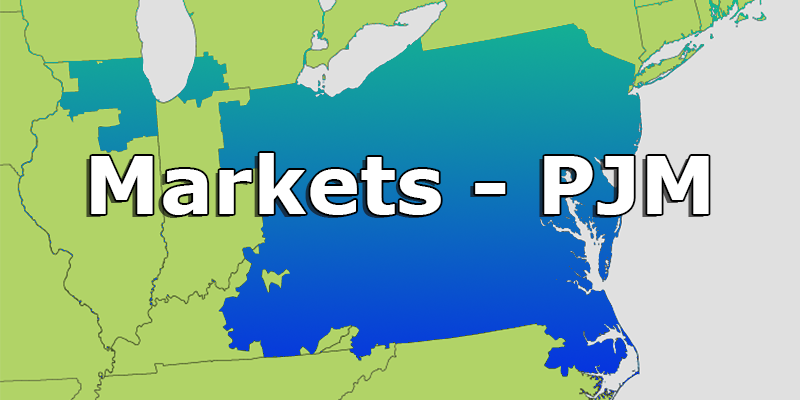We are excited to have you join us for one of our upcoming regional market webinars.
1 min read
Spring Energy Market Webinar
By 5 on February 24, 2020
Topics: Markets PJM NYISO ERCOT
3 min read
PJM Capacity - Why It's Important and What's Changing
By 5 on January 28, 2020
There has been a lot of news lately regarding capacity throughout PJM. As we have reported in the past, the Federal Energy Regulatory Commission (FERC) and PJM have been at odds over the mechanism by which the price for capacity is set. In December, the FERC issued a ruling that prescribed new rules and requirements around the auctions that establish capacity prices. Before getting into those details, we wanted to offer a quick review of what capacity is and why this issue is important.
Topics: Markets PJM
1 min read
Excess Capacity in PJM
By 5 on December 18, 2019
Despite essentially flat growth in demand, the electricity generating capacity in PJM has grown by more than 15,000 MWs from 2009 to 2017. Almost all of this additional capacity has been in the form of new natural gas plants. As a result, the reserve margin (the amount of excess capacity above peak demand) in PJM has soared. In 2018, the expected summer reserve margin was 16.1%. The actual reserve margin was more than double what was forecasted, coming in at 32.8%. This reserve margin has been increasing with time. According to the North American Electric Reliability Corporation, the anticipated reserve margin in 2021 is 45%.
Topics: Markets PJM
3 min read
A Tale of Two Power Markets
By 5 on October 24, 2019
Over the last few years, natural gas has become the fuel on the margin, meaning that the price of natural gas becomes the driver for wholesale electricity prices. Supplies of natural gas and the delivery systems necessary to transport that gas are both important factors that influence the price of electricity. Given the size of PJM, it should not be surprising that the forces affecting electricity prices in the eastern portions of PJM are different from those affecting prices in the western part of PJM. In August, a major interstate gas pipeline on the TETCO system in rural Kentucky exploded. Electricity markets in the eastern and western parts of PJM had significantly different responses to this explosion.
Topics: Markets PJM
2 min read
Bulls Arriving for 2020 and No News Isn't Good News for Capacity
By 5 on September 19, 2019
Over the last month, electricity futures in PJM have increased across all calendar years out to 2025. The most dramatic movement has been in the wholesale price of electricity for calendar year 2020. Figure 1 shows wholesale power prices in PJM East going back to the beginning of 2019. This chart shows that the price for calendar year 2020 (the dark blue line) has consistently been higher than calendar years 2021 through 2023.
Topics: Markets PJM
2 min read
Consequences of Maryland's Clean Energy Job Act
By 5 on August 16, 2019
In February 2019, Maryland’s state legislature introduced Senate Bill 516. This bill was passed by the Maryland Assembly and became law in May 2019 without Governor Hogan’s signature. This new law, known as the Clean Energy Jobs Act, increases the state’s Renewable Portfolio Standards (RPS) to 50% by 2030 and includes a mandate that 14.5% of its electricity come from solar sources by 2028. This law also puts a plan in place to increase the RPS to 100% by 2040. In addition to the state’s new RPS, the Clean Energy Jobs Act would develop one of the most aggressive offshore wind programs in the country which will create 1,200 MWs of generating capacity. By comparison, the nation’s only other active offshore wind project produces 30 MWs from 5 wind turbines off the coast of Rhode Island.
Topics: Markets PJM Education
2 min read
Electricity Futures Decrease in PJM
By 5 on August 16, 2019
Electricity futures in PJM have decreased over the course of the summer and are favorable for making longer term purchases. Figure 1 shows electricity futures prices at the PJM West trading hub (Southwestern PA) out to August 2024. The blue line is the price curve on April 8, 2019 and the black line is the price curve on August 12, 2019. In the Northeast, winter electricity prices are the primary determinant for electricity prices. Since the beginning of the summer, the peak winter price in January has fallen by 10% out to 2024 as illustrated with the green arrows. Note that the peak summer price in July of each year has also decreased materially over the last three months.
Topics: Markets PJM
3 min read
How State Green Initiatives Impact Power Markets
By 5 on July 18, 2019
Consequences of Increased State Regulations of Wholesale Energy
State Renewable Portfolio Standards and other renewable power regulations increase the cost of electricity and creates budget uncertainty. Large energy users need to follow multiple state regulations to estimate future energy costs. At 5, we are spending more and more time advising clients on state regulations as well as new local regulations that address carbon emissions. New York City just adopted building regulations that require all buildings over 25,000 square feet to reduce emissions by 40% by 2030 and by 80% by 2050. Buildings that are unable to meet emissions targets will be subject to significant fines. It will be interesting to see if other local jurisdictions follow New York City and pass regulations to address carbon usage.
Topics: Markets PJM
3 min read
Good Purchasing Options and Big Changes in Maryland
By 5 on June 17, 2019
Midwest and Mid-Atlantic (PJM)
Inexpensive spot prices for natural gas in the Midwest and Mid-Atlantic Regions have had a material impact on the spot prices for electricity inPJM. Figure 1 illustrates the monthly average Real-Time index prices for the two main trading hubs in PJM (PJM West is a broad area from Erie to DC, PJM East is the Philadelphia area and East) going back to 2016. This shows a decreasing trend in spot prices going back to last fall, following the decline in natural gas prices. It also highlights that in the last two months, spot electricity prices have settled near their lows, close to those that were set back in 2016.



